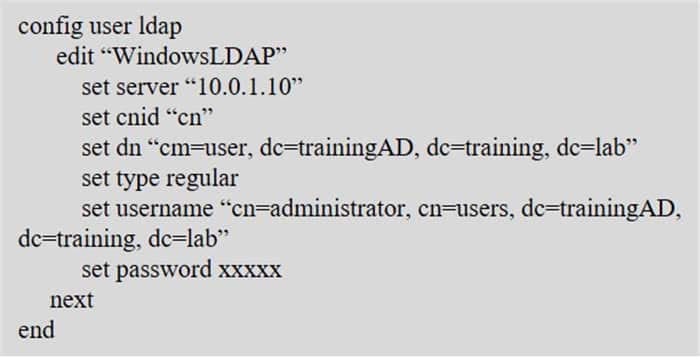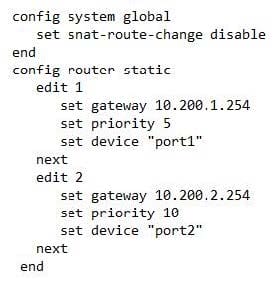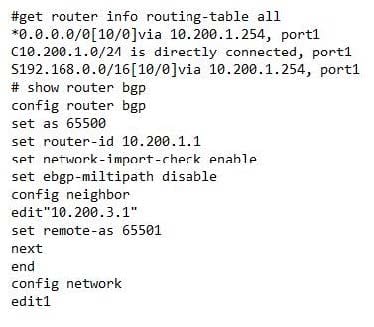NSE7_EFW Online Practice Questions and Answers
In which of the following states is a given session categorized as ephemeral? (Choose two.)
A. A TCP session waiting to complete the three-way handshake.
B. A TCP session waiting for FIN ACK.
C. A UDP session with packets sent and received.
D. A UDP session with only one packet received.
Examine the following traffic log; then answer the question below.
date-20xx-02-01 time=19:52:01 devname=master device_id="xxxxxxx" log_id=0100020007 type=event subtype=system pri critical vd=root service=kemel status=failure msg="NAT port is exhausted." What does the log mean?
A. There is not enough available memory in the system to create a new entry in the NAT port table.
B. The limit for the maximum number of simultaneous sessions sharing the same NAT port has been reached.
C. FortiGate does not have any available NAT port for a new connection.
D. The limit for the maximum number of entries in the NAT port table has been reached.
A FortiGate device has the following LDAP configuration: The LDAP user student cannot authenticate. The exhibit shows the output of the authentication real time debug while testing the student account:


Based on the above output, what FortiGate LDAP settings must the administer check? (Choose two.)
A. cnid.
B. username.
C. password.
D. dn.
How does FortiManager handle FortiGuard requests from FortiGate devices, when it is configured as a local FDS?
A. FortiManager can download and maintain local copies of FortiGuard databases.
B. FortiManager supports only FortiGuard push to managed devices.
C. FortiManager will respond to update requests only if they originate from a managed device.
D. FortiManager does not support rating requests.
Two independent FortiGate HA clusters are connected to the same broadcast domain. The administrator
has reported that both clusters are using the same HA virtual MAC address. This creates a duplicated
MAC address problem in the network.
What HA setting must be changed in one of the HA clusters to fix the problem?
A. Group ID.
B. Group name.
C. Session pickup.
D. Gratuitous ARPs.
View the exhibit, which contains the output of a diagnose command, and then answer the question below.

What statements are correct regarding the output? (Choose two.)
A. This is an expected session created by a session helper.
B. Traffic in the original direction (coming from the IP address 10.171.122.38) will be routed to the next-hop IP address 10.0.1.10.
C. Traffic in the original direction (coming from the IP address 10.171.122.38) will be routed to the next-hop IP address 10.200.1.1.
D. This is an expected session created by an application control profile.
View the following FortiGate configuration.

All traffic to the Internet currently egresses from port1. The exhibit shows partial session information for Internet traffic from a user on the internal network:

If the priority on route ID 1 were changed from 5 to 20, what would happen to traffic matching that user's session?
A. The session would remain in the session table, and its traffic would still egress from port1.
B. The session would remain in the session table, but its traffic would now egress from both port1 and port2.
C. The session would remain in the session table, and its traffic would start to egress from port2.
D. The session would be deleted, so the client would need to start a new session.
View the exhibit, which contains the output of get sys ha status, and then answer the question below. Which statements are correct regarding the output? (Choose two.)
A. The slave configuration is not synchronized with the master.
B. The HA management IP is 169.254.0.2.
C. Master is selected because it is the only device in the cluster.
D. port 7 is used the HA heartbeat on all devices in the cluster.
View the exhibit, which contains the partial output of an IKE real time debug, and then answer the question below. The administrator does not have access to the remote gateway. Based on the debug output, what configuration changes can the administrator make to the local gateway to resolve the phase 1 negotiation error?
A. Change phase 1 encryption to AESCBC and authentication to SHA128.
B. Change phase 1 encryption to 3DES and authentication to CBC.
C. Change phase 1 encryption to AES128 and authentication to SHA512.
D. Change phase 1 encryption to 3DES and authentication to SHA256.
Examine the following routing table and BGP configuration; then answer the question below.

TheBGP connection is up, but the local peer is NOT advertising the prefix 192.168.1.0/24. Which configuration change will make the local peer advertise this prefix?
A. Enable the redistribution of connected routers into BGP.
B. Enable the redistribution of static routers into BGP.
C. Disable the setting network-import-check.
D. Enable the setting ebgp-multipath.

